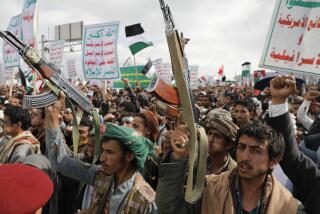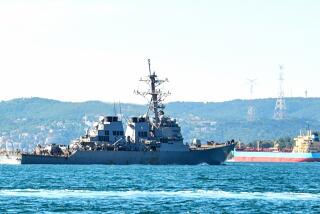Trusty Tomahawk Cruise Missile Has Become Weapon of Choice
- Share via
WASHINGTON — In unleashing a barrage of cruise missiles, the U.S. military on Thursday turned once again to a weapon that, despite limited punch, has become a favorite of Pentagon planners for its speed, stealth and low risk.
The Tomahawk cruise missile, at a price tag of $1.2 million each, can be programmed to hit targets 1,000 miles away without jeopardizing the safety of pilots or aircraft.
“With the Tomahawks, there’s no risk,” said Army Col. Richard Dunn, who recently retired as a top aide to the Army chief of staff.
The missiles carry the other advantage of conveying to terrorists abroad that they are not beyond the reach of U.S. retribution--even in the craggy reaches of Afghanistan.
In the simultaneous attacks on the terrorist facilities linked to Saudi militant Osama bin Laden, the Navy fired dozens of Tomahawks from five ships in the Arabian Sea at reported terrorist camps in eastern Afghanistan. A handful more were launched at an alleged chemical weapons plant in Khartoum, the capital of Sudan, from two ships in the Red Sea.
The missiles also can be used without tipping off the adversary in advance.
“The primary motivator here was maintaining operational secrecy,” said National Security Director Samuel R. “Sandy” Berger.
Had the military opted to deploy the Navy’s F-18 fighter-bombers, the aircraft would have needed refueling to reach Afghanistan. But the targets were within the cruise missiles’ range, because the training camps are about 500 miles from the Arabian Sea and Khartoum is 400 miles from the Red Sea.
These advantages have made the Tomahawk a favorite of the Clinton administration, as with the Bush administration before it. They were used during the 1991 Persian Gulf War, and four times since then against Iraqi President Saddam Hussein.
The twin attacks were carried out beginning at 10:30 a.m. PDT and took less than an hour, Defense Secretary William S. Cohen said. Administration officials declined at news conferences to discuss details of the bombing, but additional information was provided by Pentagon officials later in the day.
The principal drawback of the cruise missile is its limited explosive power, causing some critics to complain during the crises with Iraq that Tomahawk strikes are only “pinpricks” that wouldn’t change Hussein’s behavior.
But military officers and planners said the weapon may have enough power to take care of Thursday’s mission--to destroy Bin Laden’s weapons and training facilities.
The Khartoum chemical plant is a relatively “soft” building--meaning it is not reinforced--that the Pentagon clearly believes could be sufficiently damaged by a limited number of cruise missiles.
By contrast, the Pentagon in 1993 fired 23 cruise missiles to destroy the much larger Iraqi intelligence headquarters in Baghdad.
Military planners faced a much bigger task in trying to damage the infrastructure of the Zawa Kili al Badr terrorist training camp, southeast of the Afghan capital, Kabul. The camp is made up of dozens of single-story buildings sprawling across six sites.
Pentagon officials will not know whether they succeeded in inflicting enough damage to disable the camps until assessments expected to be conducted today are complete.
Bin Laden’s capacity to survive U.S. strikes should not be underestimated, defense officials pointed out. He survived Soviet army attacks that struck his positions over a decade during the Afghan war.
Yet some analysts were confident that the U.S. attacks did grave damage to the camps, perhaps including many dozens of casualties.
They noted that military planners have had a long time to study the camps through satellite photos and available human intelligence. Using such information, analysts believe they have probably been able to put together a list of the most important targets at the camps, which are used to train and indoctrinate terrorists in weapons and explosives.
“They probably know where all the key functions take place, and can hit those hard,” said Kenneth Pollack, a specialist on the Middle East at National Defense University in Washington.
The Tomahawk cruise missile is 18 feet long and 20 inches in diameter, and it runs on a solid fuel. It isn’t easily picked up on radar because of its compact size and doesn’t show up on infrared detectors because its engine emits little heat.
Also, the missile hasn’t set off diplomatic protests in the past when it has flown unauthorized over foreign territory, as it did over Iran during the Gulf War.
But the Tomahawk makes a striking sight when seen from the ground.
“It looks like a huge motorboat cruising through the air,” Pollack said. “It’s a big hunk of thing.”
During the Gulf War, the missiles were laboriously programmed to follow maps of the contour of the Earth, a complex process.
Newer models are much easier to direct toward their targets; they come equipped with a built-in global positioning system that only requires technicians to punch in geographic coordinates.
“Punch in the numbers, fire it off and wait for an explosion that’s too far off even to hear,” said one officer, who described the missile as “an incredible Tom Clancy toy.”
(BEGIN TEXT OF INFOBOX / INFOGRAPHIC)
Attack Weaponry
Tomahawk cruise missiles launched from Navy ships in the Red Sea and Arabian Sea carried out attacks on sites in Afghanistan and Sudan. This unmanned weaponry was also used during the Persian Gulf War, but has since been upgraded for use with global positioning satellites.
(1) The missile is launched vertically from a missile destroyer or a cruiser. After launch, tailfins and wings deploy.
(2) A solid propellant powers the missile until a small turbofan engine takes over for the cruise portion of flight.
(3) The missile descends to a very low altitude to avoid radar detection as it heads for land.
(4) To determine correct positioning as it travels--including changes in altitude of terrain--the missile uses the global positioning system, or GPS. When target coordinates are reached, missile hits straight on or rises to strike from above.
****
Tomahawk at a glance
* Length: 18 ft. 3 in.
* Diameter: 20.4 in.
* Wingspan: 8 ft. 9 in.
* Cruise engine: 606 pounds of thrust, turbofan
* Range: 690 miles
* Cruising speed: 550 mph
More to Read
Sign up for Essential California
The most important California stories and recommendations in your inbox every morning.
You may occasionally receive promotional content from the Los Angeles Times.













